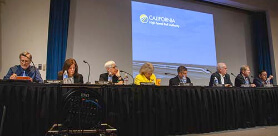CEO Report
 August 2021
August 2021
This edition of the CEO Report was delivered by Authority Chief Executive Officer Brian Kelly.
FEDERAL INVESTMENT
INFRASTRUCTURE INVESTMENT AND JOBS ACT
There is legislation moving at the federal level to invest in infrastructure and I wanted to go through how we can access that right now, with the note that it is not done going through the process.
I wanted to describe what is in some of the federal legislation that is pending. I see it optimistically because of the volume of dollars in it. And while c we will be in a competitive mode for those dollars, the reason I push our Board of Directors to approve the Bakersfield to Palmdale environmental document is so that we can move to the next stage of project development up and down the state of California —statewide, and access federal or other funds, to help us move the project forward.
I wanted to update the Board on the status of the federal bill, and how it affects us, what is to come and what to watch out for in the next week or two at the federal level. There will be time to come back to the Board; when we’ll know exactly what is in it for the Authority and we can talk about various options for us.
The following is just a simple chart, which may look familiar to the Board as we talked to you when the Biden Administration first pitched the Build Back Better Program.
These are pots within the federal bill that reflect what they call the bipartisan agreement. This is the bill that was approved by the Senate on a 69 to 30 vote about two weeks ago and I wanted to walk through this because there was a lot of noise about how much is in for high-speed rail and how much is not in for high-speed rail.
From where I sit, I see opportunity.
A lot of opportunity—and it is important to note for the Board that this level of investment for transportation and in rail has not occurred in 20 or 30 years. This is not a small matter and so I wanted to go through what we see in the federal bill and why we see opportunity here and then note what we think is yet to come as it gets back to the House for consideration.
There are six different competitive programs that are getting substantial sums of money that we compete in today.
NATIONAL INTERCITY PASSENGER RAIL
- High-speed rail and all intercity rail expansion projects with an emphasis in speed, time improvements, electricity improvements and clean options for passenger rail improvements.
- Multi-year commitments possible
A bill that came out of the Senate has $12 billion appropriated, which means those dollars can be used by executive branch agencies to make available to applicants immediately, authorizing an additional $4.1 billion, which totals $16 billion that is essentially mirrored on the same pot where we got our original federal funding from. We look at this and say this is certainly a pot we will compete in and we will be prepared to seek federal funds.
CONSOLIDATED RAIL INFRASTRUCTURE AND SAFETY IMPROVEMENTS (CRISI)
- Capital projects that will improve passenger and freight rail transportation systems in the terms of safety, efficiency, or reliability
CRISI grants is a familiar federal pot s focused on capital projects that improve passenger and freight rail transportation systems in terms of safety, efficiency, and reliability. We have been supporters of CRISI grants in the past and we have worked with local agencies to apply for CRISI grants. This bill appropriates $5 billion for that program, authorizes an additional $5 billion to total a $10 billion pot for elements of our project that we may be able to align and would be CRISI grant appropriate. This is for capital projects that improve passenger-freight rail transportation systems in terms of safety, efficiency, reliability. Grade separation are also in this program.
NATIONAL/REGIONAL SIGNIFICANCE (MEGA PROJECT)
- Broad eligibility for different types of infrastructure
National/Regional Significance also known as the Mega Project is a brand-new federal program in this legislation with no history. This is a program that’s got appropriated and authorized funds totaling $10 billion. The emphasis of this program is to improve inner-city passenger rail performance, reduce trip time, increase frequencies, increase higher operating speeds, expand capacity, and support electrification of rail and again this is a new pot—there are all kinds of mega projects that can participate in this. Competitiveness, economic development, GHG reduction are all elements for this program and how these dollars will be delivered throughout the country. This is a $10 billion federal program that is pending in the Senate bill that passed four projects that certainly we look at this and say we are prime to compete for and expect to.
REBUILDING AMERICAN INFRASTRUCTURE WITH SUSTAINABILITY AND EQUITY (RAISE)
- Invest in road, rail, transit and port projects that promise to achieve national objectives
Rebuilding American Infrastructure with Sustainability and Equity are called RAISE grants. We currently have two RAISE grants pending with the FRA and we are hoping to hear how those go come November. These are projects that invest in road, rail, transit, or port project that promise to achieve any national objectives. Those are safety, increased in inner-city rail, projects.
We are applying these grants for advance planning at the Palmdale station, and we are applying for what we are doing in Wasco currently pending applications for the RAISE grant. This is a place we play $7.5 million is appropriated in the Senate bill for that program.
INFRASTRUCTURE FOR REBUILDING AMERICA (INFRA)
- Fund highway and freight projects of national and regional significance
- Available for rail/highway crossing projects
Infra grants—we just applied for them at the federal level, in this case we didn’t get it in this round, but we are eligible to be continued applicants going forward and again freight projects of national regional significance are available for rail and highway crossing projects.
You heard in the presentation today, as we come into Palmdale, we align a rail corridor that includes us, Metrolink and freights in a series of 11 grade separations to make that a more efficient stretch. That is the kind of project the infra grant can apply to. It is up to us assess all of this align a strategy to compete for these funds for components of our project and then get to work.
RAIL/HIGHWAY CROSSING ELIMINATION
- Highway-rail grade crossing improvement projects that focus on improving the safety and mobility of people and goods
This is a long-standing program that has been in the highway trust for several years focused on safety of lot, grade separation elements in this program. This is what you call contract authority for 2.5 billion with 3 billion appropriated in the bill. The contract authority means that as its part of the highway trust fund, it does not require a future appropriation to be released and the executive agencies can put these dollars to work.
GRANTS SUMMARY
We are looking at six competitive pots with different sources of funding that are available for elements of our project or elements of what we do. Those six pots combined to include about $57 billion available in the Senate bill. Yes, we must compete, we must go do our work, and we are well positioned to do that. Some pots are more favorable for specifically what we are proposing to do and some that are better for components of the project like grade separation.
This is the bill that passed the Senate, the leadership of the House is calling back house members next week starting on Monday, August 23. There are two things going on that the Board should be aware of:
- This Senate bill is now in the House for action and indications are that house leadership will not act on this bill, until they at least pass the budget reconciliation that is a larger bill to deal with other infrastructure items.
- DeFazio, who is the chair of the house transportation infrastructure committee, said he was going to use that reconciliation process. He wrote a letter to his colleagues and will use that reconciliation process to remedy some of the flaws he saw in the Senate bipartisan bill and intend to focus on programs that reduce carbon emissions from surface transportation and specifically look at increasing funding for ports, more transit funding, reconnect neighborhoods and, per his letter, robustly funding high-speed rail.
As the House comes backs and look at how they act on both the reconciliation letter and this infrastructure bill, we see the opportunity in the Senate bill now, and we see potential for more funding available for this program as the House takes up the work.
This will be something to watch over the course of the next couple of weeks and I am hopeful by the end of August, we will have a clear sense of what the federal bill and the opportunity it presents for us. We must strategize and make sure we are putting together opportunities and programs to invest in elements of this program. It will be up to the Board and others to determine whether we want to as we had proposed in our business plan get the segment going in the Valley, complete our work there and at the same time find those places for targeted investments up and down the state.
The biggest thing that has changed in this conversation is that for four years we have had no federal partner on this program—not only not funding, transit, high-speed rail, or any infrastructure but also being aggressively against it. What we are now seeing in the new administration is a massive change that says not only are we for these things, but we are putting major investment on the table.
You heard the mayor of Fresno earlier today, he talked about what the President said to him about the investment in high-speed rail and infrastructure and I think there is great opportunity in front of us. I am looking forward to getting to work and strategizing with the Board on how we bring these dollars to use for this project. It is extremely encouraging as the House comes back and takes up the work, but I am hopeful that by the end of August we will have a clearer picture.
JOBS, SUSTAINABILITY, CONSTRUCTION UPDATE – LOOK AHEAD
We are doing a labor jobs update on the program and we have a new Sustainability Report coming up—this is an annual report that will be out in September and we will be presenting it to the Board.
You may remember in May presented a construction update for each of the construction packages on this program and project. I think it was well received by the Board and one of the members asked if we could do this quarterly and so the next update will be in October hearings to update the status of each of the construction packages.
Also, we have been on course with what’s going on in public health and we have been on course to get back into in-person meetings in October. We are still working and watching what is happening with the rise of the different variants of COVID.
The state of California and agencies will guide by public health and issues.


